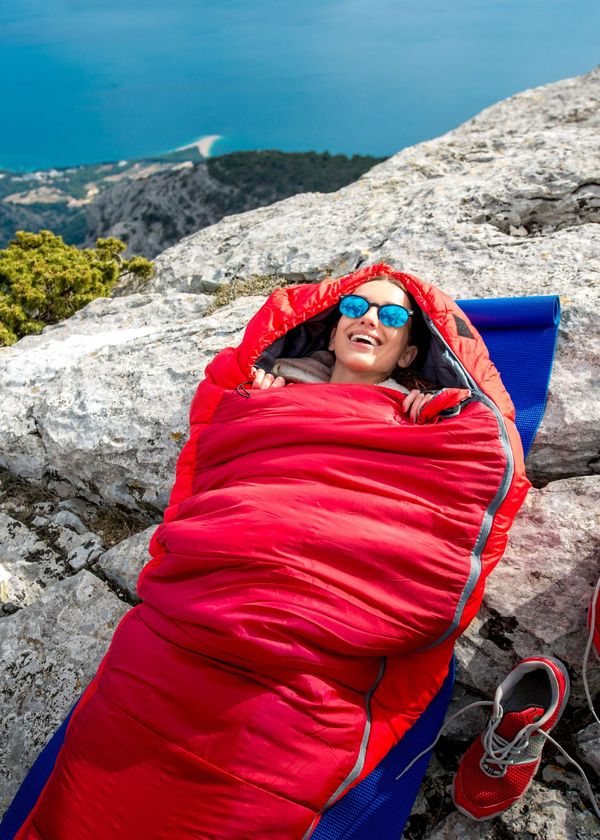How to tie a portable hammock knot? Learn more about hammocks and how to tie a hammock with them!
Hammocks are a great way to relax and enjoy the outdoors. When it comes to portable hammocks, they provide convenience, as they can be easily moved and set up in different locations.
However, it can be a bit tricky to tie one knot on a portable hammock, especially if you are a beginner. In this article, we will provide you with some guidelines on how to tie a portable adjustable hammock knot.

Choosing the Right Location
Before you tie your portable hammock to a tree, you need to choose the right location for it. Look for a spot that has sturdy trees or poles that can support your hammock. Make sure there is enough space for your hammock to stretch out, as well as for you to move your hammock rope all around comfortably while in it.
Setting Up the Hammock Straps
Most portable hammocks come with straps that you can use to tie the hammock to dead branches of trees or poles. Here are the steps to set up the hammock straps:
- Find two sturdy trees or poles that are at least 12 feet apart.
- Wrap the straps around the trees or poles, making sure they are at the same height.
- Insert one end of the strap through the loop on the other end of the strap.
- Tighten the strap by pulling it through the loop.
- Repeat on the other side.
Placing the Hammock
Once the straps are set up around the tree, you can place your hammock onto them. Here are the steps to place tree straps on your hammock:
- Find the center point of your hammock.
- Attach one end of your hammock to one of the straps by slipping the carabiner through the loop on the strap.
- Repeat on the other end.
- Adjust the tension on the straps to ensure the hammock is level and comfortable.
- Test the hammock by sitting in it and adjusting the straps as needed.
Tips for a Safe and Comfortable Hammock Experience
Here are some tips to ensure you have a safe and comfortable hammock experience:
- Always check the weight limit of your hammock before use. Do not exceed the weight limit.
- Make sure the straps are securely attached to the trees or poles.
- Test the hammock by sitting in it before lying down to make sure it is secure.
- Do not jump or do any other activity that could cause the hammock to become unstable.
- Avoid tying your hammock too tightly or too loosely, as this can affect your comfort and safety.
- Bring a cushion or pillow to enhance your comfort while in the hammock.
- Make sure you are at a safe height from the ground. Do not hang your hammock too high, as falling from a hammock can result in serious injury.

How do you hang a portable hammock?
Hanging a portable hammock is surprisingly easy and does not require any special tools. The most important thing to consider when hanging a portable hammock is finding two sturdy trees or other tree supports that are far enough apart for the length of rope attached to your hammock.
Once you’ve selected your two supports, the next step is to securely tie each end of the hammock overhand knot around the end of the rope support using rope, straps, carabiners, or webbing loops designed to work with portable hammocks.
Ensure that both ends are tied at roughly the same height off the ground so that you have an even surface while lying in it. Finally, adjust each knot correctly from the tail end until you find a comfortable position, and make sure that all knots are secure.
What is the best knot for tying up a hammock?
The best knot for tying up enough excess rope for two ropes in a hammock depends on the hammock you use. There are many different knots that can be used, but some may be better suited for certain types of hammocks than others.
For example, if you are using a rope hammock, tying knots with a bowline knot is often recommended, as it allows for tension and excess rope to be adjusted easily and securely. On the other hand, if you have a fabric or netted hammock, the figure eight knot is usually preferred due to its simple construction and easy untying when needed.
Regardless of which type of rope tight or hammock knot you use, make sure that it is tied securely so that your hammock is held firmly in place and will not become loose or slip away! Additionally, always double-check that all knots are tied correctly so as to avoid any mishaps or accidents. You can ensure a safe and comfortable hammock experience with the right knot!

How do you hang a hammock without a rope?
Hanging a hammock without a top rope around the tree is possible, but it requires two sturdy anchor points and hardware such as large hooks or eye screws to attach the hammock to two trees.
The two anchor points should be at least 8 feet apart for a single hammock and 16 feet apart for a double hammock. If you don't have a hammock stand or access to other hammock camping hardware, you can also use straps or chains rated for outdoor use.
To hang your hammock using straps or chains, loop them around the anchor points and secure them with carabiners or knots. Once the loop's tight anchors are in place, you can thread the loops through the pre-made holes in your hammock or tie it securely with knots to hang evenly.
Can I hang a hammock without straps?
Hanging a hammock without straps and enough rope is possible, but it's not recommended. Straps are the safest and most secure way to hang a hammock since they provide extra stability and support that can't be achieved with rope or other materials alone.
Additionally, straps are adjustable so you can hang your hammock at just the right height for maximum comfort. Without straps, you risk your hammock falling or sagging too much, which could cause injury if you're in it when it happens. For these reasons, it's best to use straps whenever possible when hanging a hammock.
Conclusion
Tying a portable hammock can be a bit tricky at first, but with the right instructions and practice, you can enjoy relaxing in your hammock with ease.
Remember to choose a safe and comfortable location for your hammock, set up the best hammock knots and straps correctly with a taut line hitch, and follow the tips for a safe and enjoyable hammock experience. With these guidelines in mind, you can sit back, relax, and enjoy the great outdoors in your portable hammock.









